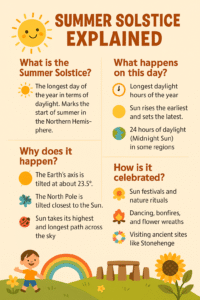Amazing Facts About Summer Solstice: 7 Reasons to Celebrate the Longest Day of the Year
Summer Solstice: A Celestial Celebration of Light and Life 🌞

Every year, nature marks a remarkable moment when the Sun reaches its highest point in the sky—this is known as the Summer Solstice. It’s the longest day and shortest night of the year, filled with sunshine, symbolism, and cultural celebrations across the globe.
The Summer Solstice is not just a day of extra daylight, but also one of deep astronomical and spiritual significance. Whether you’re a science enthusiast, a nature lover, or someone looking to reconnect with ancient traditions, the Summer Solstice has something special for everyone.
What is the Summer Solstice?

The Summer Solstice occurs when the Earth’s axial tilt is most inclined toward the Sun, bringing the Northern Hemisphere its longest daylight period of the year. Typically falling on June 20th or 21st, it signals the start of astronomical summer.
In 2025, the Summer Solstice will occur on June 21st at approximately 2:43 a.m. UTC.
This event marks the moment when the Sun is directly over the Tropic of Cancer. From this point on, the days begin to slowly shorten, making it a turning point in the annual solar cycle.
1. A Day of Maximum Sunlight 🌞
On the Summer Solstice, regions in the Northern Hemisphere can enjoy up to 17 hours of daylight! Places near the Arctic Circle even experience 24 hours of sunlight, often called the Midnight Sun. This incredible natural light show is a reason to step outside, celebrate, and embrace nature.
2. The Solstice Is Rooted in Ancient Traditions
Cultures around the world have long observed the Summer Solstice with festivals, rituals, and celebrations:
Stonehenge in England aligns perfectly with the rising sun on the solstice.
In Sweden, people celebrate Midsummer with flower crowns, dancing, and feasts.
Native American tribes, like the Sioux, held sun dances to honor life and nature.
In India, International Yoga Day falls on June 21st to align with the energy of the sun.
These time-honored practices reflect humanity’s deep connection to the sun and seasons.
3. It’s Scientifically Fascinating 🔭
This Solstice helps scientists understand the Earth’s axial tilt and orbit. It plays a crucial role in studying the Earth’s climate, weather patterns, and solar energy. Schools and educators often use this day to spark interest in astronomy and Earth science.
4. A Perfect Day for Outdoor Activities
Thanks to the extended daylight, this Solstice is the ideal time for family picnics, evening walks, stargazing, and sunlit adventures. Whether you’re gardening, hiking, or hosting a barbecue, nature seems to smile more brightly on this special day.
5. Boost Your Mood with Sunlight ☀️
Sunlight plays a major role in boosting mood and regulating sleep through the production of Vitamin D and serotonin. The Summer Solstice is the perfect opportunity to soak in those extra rays (with sunscreen, of course!) and feel more energized and positive.
6. Farmers and Gardeners Mark the Season
For centuries, farmers have relied on the Summer Solstice to guide planting and harvesting cycles. Even today, gardeners observe this date as a milestone in the growing season. It’s a signal that summer crops should thrive and blossom in the weeks to come.
7. A Reminder to Pause and Reflect 🌼
Spiritually, the Summer Solstice invites reflection, gratitude, and intention setting. As the sun peaks in the sky, it symbolizes enlightenment, growth, and clarity. Many people use this day to journal, meditate, or set new goals aligned with the solar energy of renewal.
Why the Summer Solstice Still Matters Today
Even in our modern digital age, the Summer Solstice serves as a powerful reminder of our connection to the natural world. It’s a day to celebrate warmth, light, growth, and community.
From ancient megaliths to modern wellness movements, this annual solar event continues to unite people across cultures and continents.
Celebrate the Summer Solstice with Your Family
Make the Summer Solstice a special day in your family calendar:
Watch the sunrise or sunset together
Enjoy a nature walk or garden picnic
Create sun-themed crafts with kids
Practice yoga or meditation outdoors
Write down goals or things you’re grateful for
By honoring this natural phenomenon, you build a deeper appreciation for the Earth’s rhythms and seasons.
Final Thoughts
The Summer Solstice is more than just the longest day of the year—it’s a cosmic celebration of life, light, and learning. With ancient roots and modern significance, this day is perfect for pausing, appreciating nature, and embracing the joy of summer.
So, mark your calendar, step outside, and let the sunshine in!
See more: https://nikitadigistore.com/product/solar-system-coloring-book/
